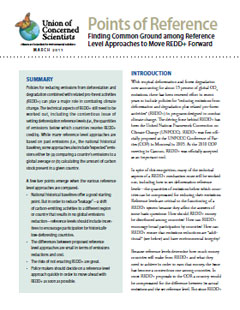Policies for reducing emissions from deforestation and degradation combined with related pro-forest activities (REDD+) can play a major role in combating climate change. The technical aspects of REDD+ still need to be worked out, including the contentious issue of setting deforestation reference levels (i.e., the quantities of emissions below which countries receive REDD+ credits). While many reference level approaches are based on past emissions (i.e., the national historical baseline), some approaches also include “expected” emissions either by (a) comparing a country’s emissions to a global average or (b) calculating the amount of carbon stock present in a given country.
A few key points emerge when the various reference level approaches are compared:
- National historical baselines offer a good starting point. But in order to reduce “leakage”—a shift of carbon-emitting activities to a different region or country that results in no global emissions reduction—reference levels should include incentives to encourage participation by historically low-deforesting countries.
- The differences between proposed reference level approaches are small in terms of emissions reductions and cost.
- The risks of not enacting REDD+ are great.
- Policy makers should decide on a reference level approach quickly in order to move ahead with REDD+ as soon as possible.




